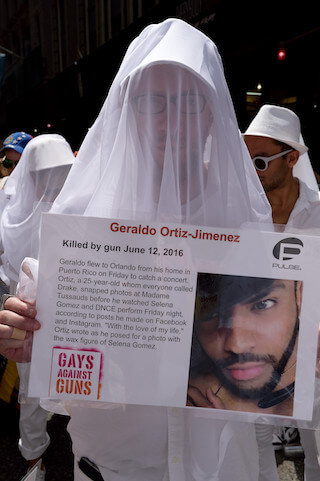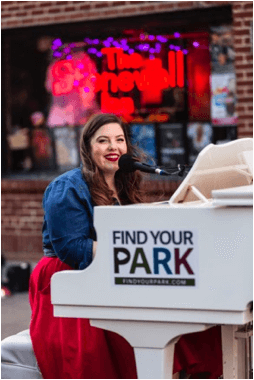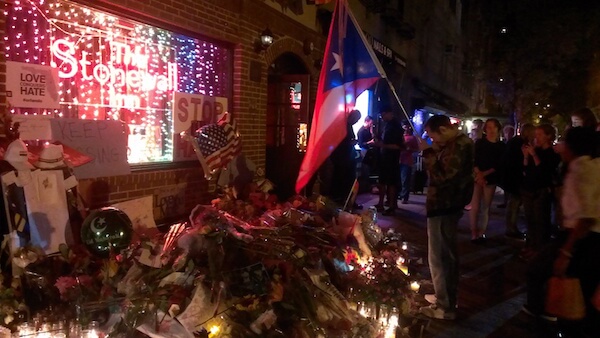RIOT! in Bushwick on June 27. | MARK DOMMU
Armed with a small coffee as I walked up to a Bushwick warehouse on June 27, I was ready to start my Pride Weekend — my first in New York — at the radical queer party RIOT! Maneuvering between a U-Haul truck and a fence, I could feel the heat spewing out of the entrance that lay feet in front of me. It was going to be a hot weekend in the city.
Inside the warehouse, people lined the walls conversing with one another and ordering drinks from a lemonade stand-type bar in the back of the room. Dance videos played on loop behind the stage as partygoers crowded the dance floor, stripping off their shirts to beat the heat.
Well after midnight, the Culture Whore, consisting of Mark Dommu and Paul Leopold, who hosted the party alongside David Sokolowski, introduced the first round of performers before taking the stage themselves.
Drag queens wrestling in Bushwick, smiling dykes honoring their outrage, and a sweet spot out front of Stonewall
The duo’s performance started out as a friendly game show to win money. “After all that’s what Pride is all about,” Dommu exclaimed into the microphone, as he rubbed his fingertips together in the universal sign for money. The performance took a chaotic turn when they handed out cereal to start a food fight and then shamed the audience to help clean it up.
“When the three of us decided to throw a Pride party, we realized that we were really fed up with what Pride has become,” Dommu explained. “We just kept talking about how Pride originally started as a riot, and now there’s this sense of complacency today.”
Setting out to bring back the sense of being angry and fighting for what still needs to be done in the queer community, the three men put together a list of performances that would be entertaining but still have a deeper meaning. The most popular was the final performance, which involved drag queens wrestling in a kiddie pool covered in Cool Whip. Dancers in the hot warehouse crowded the stage as Brooklyn queens climbed into the pool and started ripping off their opponents’ clothes.
“A riot is people coming together and using their bodies to make a statement, and seeing these queens lose what makes them queens was a very meaty way to signify a riot,” Dommu said. “Honestly, it was the best party we’ve ever thrown.”
Jade Obler and Jude Diebold at the June 28 Dyke March. | RYAN HOWE
The next day, I drowsily made my way toward Bryant Park, where the Dyke March was set to start. As soon as I reached the steps of the New York Public Library, however, I was wide awake. The steps were crowded with a jarring mixture of out-of-towners visiting the Beaux-Arts landmark guarded by two stately lions and raucous lesbians taking selfies with friends. The unsuspecting tourists had no idea that they were about to witness the beginning of the 22nd Annual Dyke March.
Sitting in front of a tour group on the steps were Jude Diebold, 27, and Jade Obler, 25, with their arms interlocked. The blocky letters on Diebold’s pink tank top reading “Live And Let Lez” and her girlfriend’s black T-shirt shouting “Smash Capitalism!!!” seemed appropriate for the march.
According to the Dyke March’s mission statement the annual event is “a protest march, not a parade — we don’t ask for a permit, because we have the right to protest.”
Every year thousands of lesbians gather in the spirit of what Pride started out as — a fight against ongoing discrimination targeting the LGBT community. That’s the main draw for Diebold and Obler.
“It’s great because we all are coming together without giant corporate floats or glitter — well, maybe there is some glitter,” Diebold said as she looked around. “It’s very grassroots and exciting, we come with these handmade signs and just march down the street for everyone to see that we are here and we won’t be ignored.”
This was Diebold’s fourth time at the Dyke March, but only Obler’s first.
As soon as the sound of drums came from the street, both women stood up and quickly walked up to the sidelines. Holding hands as the front banner passed them, Obler’s mouth stretched into smile. They watched as women holding up signs they’d made themselves and a second drum line passed by before they jumped into the crowd and started walking southbound.
“It’s beautiful,” Obler said as she passed 39th Street. Directly on her right, eight women stood holding hands in a straight line, barricading any traffic that might try to pass through the march, each wearing a light blue shirt with the word “DYKE” stretched across the back. Cross-town traffic, however, was already being detoured away from Fifth by police stationed a block down from both sides of the avenue.
The couple walked hand in hand for blocks, stopping occasionally to talk with friends or take pictures of signs about femme visibility or the right to abortion.
“It’s not only beautiful because of dykes coming together from all ages and taking the street as their own,” Obler explained. “It stands for something that the LGBT community seems to stray away from. It keeps the idea of fighting back against what people perceive to be normal. It’s my own Pride parade, and I know this sea of lesbians will continue to march every year for what they believe in.”
Walking behind the couple approaching Washington Square Park, I noticed a small tattoo peeking out of the top of Diebold’s pink tank top that read, “I will respect my outrage.”
Sharle Kruger (far l.), Victoria Righthand (flowers in her hair), and Sasha Lamb (far r.), with five friends outside the Stonewall during the LGBT Pride March on June 29. | RYAN HOWE
On the final day of Pride Weekend, I was rested enough to to make my way to the parade early. After rubbing aloe on my new sunburn and stopping at Doughnut Plant, where I ordered a pink Pride doughnut, I made my way to Christopher Street.
Covered in Pride memorabilia and homemade T-shirts declaring their sexuality proudly, people slowly filled the street. Standing in front of the iconic Stonewall, which sparked a tradition that has lasted 45 years, eight women stood in a circle waiting for the parade to start.
As a police car drove by with sirens blaring and lights flashing, the crowd starting clapping and Sasha Lamb, 22, turned to her friends, her face brightened. “There’s something ironic about cheering the police outside of Stonewall,” she said.
It was Lamb’s first time attending a Pride parade. Identifying as queer, she was excited to see so many people come together in the spirit of being gay and being proud.
“It’s phenomenal to see how far the community has come in the last 45 years,” she said as she scanned the crowd. “Look around, everyone is smiling and happy it’s a bit overwhelming. I can’t think of a better place to be today. I can’t think of better people to spend the day with.”
The seven women standing alongside Lamb all came to Pride for similar reasons, but with different expectations. Another newcomer to NYC Pride, Sharle Kruger, 26, expected Christopher Street to be more risqué. As she looked down the street at the rainbow flags waving in the gentle but constant breeze, she was shocked to see how conservatively most people were attired. Aside from the occasional bikini or man wearing nothing but underwear, most people were fully dressed.
It’s not the same atmosphere in South Africa, where she normally spends Pride.
“I expected to see a lot of naked people,” she explained. “Where I’m from, everyone comes dressed in gold booty shorts and nothing else. It’s on a much smaller scale, but the people get really into it.”
Unlike her friends, Victoria Righthand, 25, is a Pride veteran here in New York. A few years ago, she scoped out her spot in front of Stonewall where she could watch the parade and get drinks throughout the day.
It’s also the atmosphere that brings her back to the same spot every year.
“To me, Pride is about celebrating the victories that we have already accomplished, but it’s also coming together in the spirit of Stonewall and using this huge celebration to make us visible so the issues we still have to face are visible, too,” she said. “So I’m here to celebrate.”
The diverse group of friends waited a little while longer for the parade to start, and once it did all eight pressed themselves up against the metal police railing.
I walked away as they started dancing to Big Frieda on the Diet Coke float. As I made my way down Christopher Street watching a sea of people cramming close up to the railing, I could see that there isn’t a wrong way to celebrate Pride. Just bring some sunscreen is the only general rule of thumb I can offer.





































